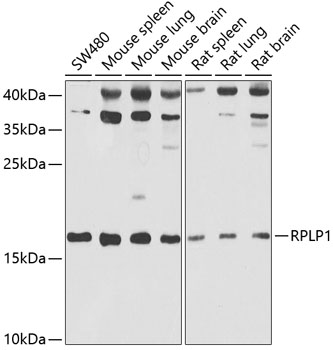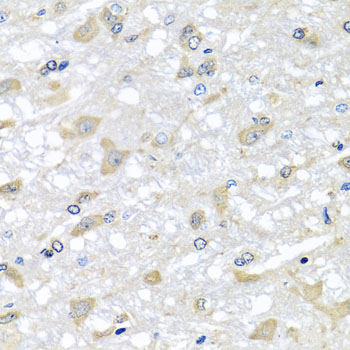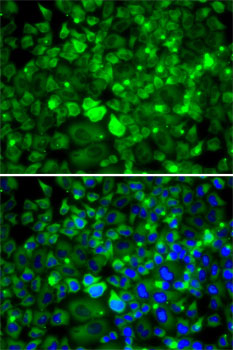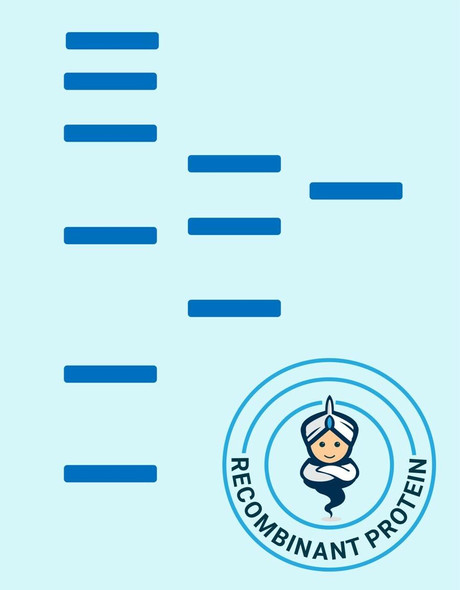Anti-RPLP1 Antibody (CAB6725)
- SKU:
- CAB6725
- Product type:
- Antibody
- Reactivity:
- Human
- Mouse
- Rat
- Zebrafish
- Host Species:
- Rabbit
- Isotype:
- IgG
- Antibody Type:
- Polyclonal Antibody
- Research Area:
- Cell Biology
Frequently bought together:
Description
| Antibody Name: | Anti-RPLP1 Antibody |
| Antibody SKU: | CAB6725 |
| Antibody Size: | 20uL, 50uL, 100uL |
| Application: | WB IHC IF |
| Reactivity: | Human, Mouse, Rat, Zebrafish |
| Host Species: | Rabbit |
| Immunogen: | Recombinant fusion protein containing a sequence corresponding to amino acids 1-114 of human RPLP1 (NP_000994.1). |
| Application: | WB IHC IF |
| Recommended Dilution: | WB 1:500 - 1:2000 IHC 1:50 - 1:200 IF 1:50 - 1:100 |
| Reactivity: | Human, Mouse, Rat, Zebrafish |
| Positive Samples: | SW480, Mouse spleen, Mouse lung, Mouse brain, Rat spleen, Rat lung, Rat brain |
| Immunogen: | Recombinant fusion protein containing a sequence corresponding to amino acids 1-114 of human RPLP1 (NP_000994.1). |
| Purification Method: | Affinity purification |
| Storage Buffer: | Store at -20°C. Avoid freeze / thaw cycles. Buffer: PBS with 0.02% sodium azide, 50% glycerol, pH7.3. |
| Isotype: | IgG |
| Sequence: | MASV SELA CIYS ALIL HDDE VTVT EDKI NALI KAAG VNVE PFWP GLFA KALA NVNI GSLI CNVG AGGP APAA GAAP AGGP APST AAAP AEEK KVEA KKEE SEES DDDM GFGL FD |
| Gene ID: | 6176 |
| Uniprot: | P05386 |
| Cellular Location: | |
| Calculated MW: | 8kDa/11kDa |
| Observed MW: | 17kDa |
| Synonyms: | RPLP1, LP1, P1, RPP1 |
| Background: | Ribosomes, the organelles that catalyze protein synthesis, consist of a small 40S subunit and a large 60S subunit. Together these subunits are composed of 4 RNA species and approximately 80 structurally distinct proteins. This gene encodes a ribosomal phosphoprotein that is a component of the 60S subunit. The protein, which is a functional equivalent of the E. coli L7/L12 ribosomal protein, belongs to the L12P family of ribosomal proteins. It plays an important role in the elongation step of protein synthesis. Unlike most ribosomal proteins, which are basic, the encoded protein is acidic. Its C-terminal end is nearly identical to the C-terminal ends of the ribosomal phosphoproteins P0 and P2. The P1 protein can interact with P0 and P2 to form a pentameric complex consisting of P1 and P2 dimers, and a P0 monomer. The protein is located in the cytoplasm. Two alternatively spliced transcript variants that encode different proteins have been observed. As is typical for genes encoding ribosomal proteins, there are multiple processed pseudogenes of this gene dispersed through the genome. |
| UniProt Protein Function: | RPLP1: Plays an important role in the elongation step of protein synthesis. Belongs to the ribosomal protein L12P family. |
| UniProt Protein Details: | Protein type:Translation; Ribosomal Chromosomal Location of Human Ortholog: 15q22 Cellular Component: cytoplasm; cytosol; focal adhesion Molecular Function:protein binding; protein kinase activator activity; structural constituent of ribosome Biological Process: mRNA catabolic process, nonsense-mediated decay; positive regulation of protein kinase activity; rRNA processing; SRP-dependent cotranslational protein targeting to membrane; translational initiation; viral transcription |
| NCBI Summary: | Ribosomes, the organelles that catalyze protein synthesis, consist of a small 40S subunit and a large 60S subunit. Together these subunits are composed of 4 RNA species and approximately 80 structurally distinct proteins. This gene encodes a ribosomal phosphoprotein that is a component of the 60S subunit. The protein, which is a functional equivalent of the E. coli L7/L12 ribosomal protein, belongs to the L12P family of ribosomal proteins. It plays an important role in the elongation step of protein synthesis. Unlike most ribosomal proteins, which are basic, the encoded protein is acidic. Its C-terminal end is nearly identical to the C-terminal ends of the ribosomal phosphoproteins P0 and P2. The P1 protein can interact with P0 and P2 to form a pentameric complex consisting of P1 and P2 dimers, and a P0 monomer. The protein is located in the cytoplasm. Two alternatively spliced transcript variants that encode different proteins have been observed. As is typical for genes encoding ribosomal proteins, there are multiple processed pseudogenes of this gene dispersed through the genome. [provided by RefSeq, Jul 2008] |
| UniProt Code: | P05386 |
| NCBI GenInfo Identifier: | 133051 |
| NCBI Gene ID: | 6176 |
| NCBI Accession: | P05386.1 |
| UniProt Secondary Accession: | P05386,A6NIB2, |
| UniProt Related Accession: | P05386 |
| Molecular Weight: | 8,804 Da |
| NCBI Full Name: | 60S acidic ribosomal protein P1 |
| NCBI Synonym Full Names: | ribosomal protein lateral stalk subunit P1 |
| NCBI Official Symbol: | RPLP1 |
| NCBI Official Synonym Symbols: | P1; LP1; RPP1 |
| NCBI Protein Information: | 60S acidic ribosomal protein P1 |
| UniProt Protein Name: | 60S acidic ribosomal protein P1 |
| UniProt Gene Name: | RPLP1 |
| UniProt Entry Name: | RLA1_HUMAN |











